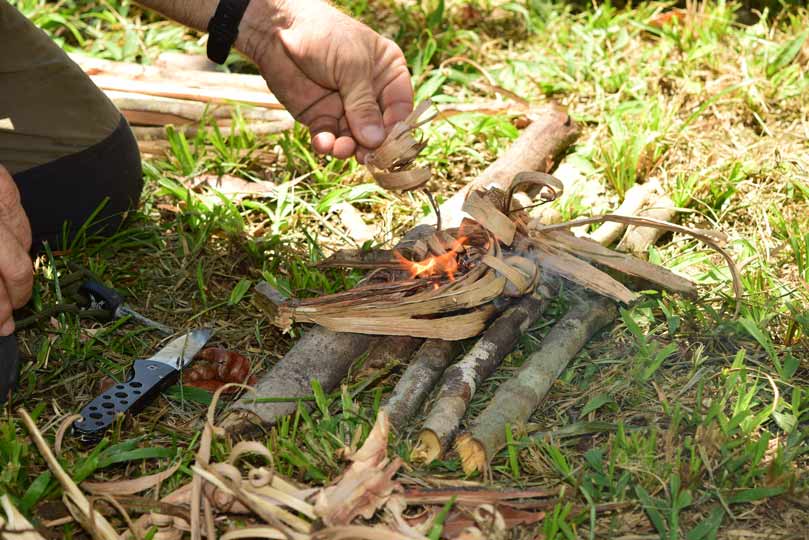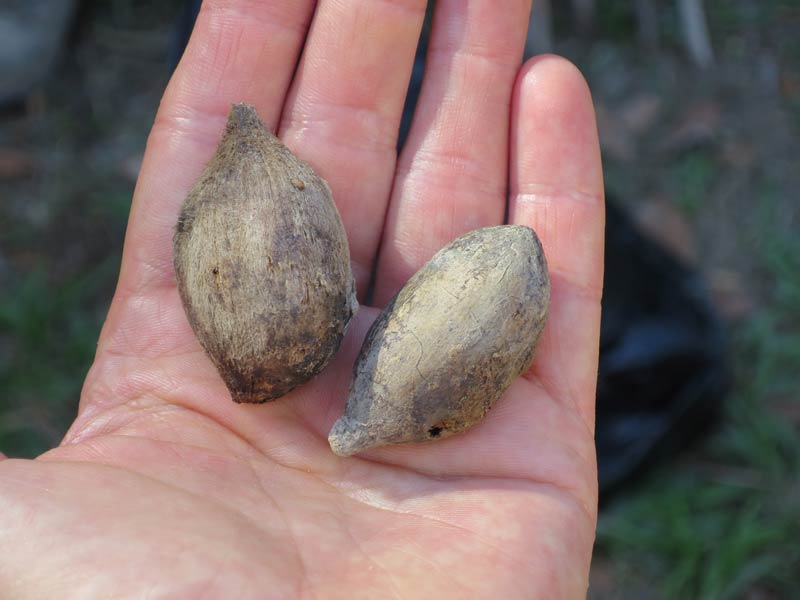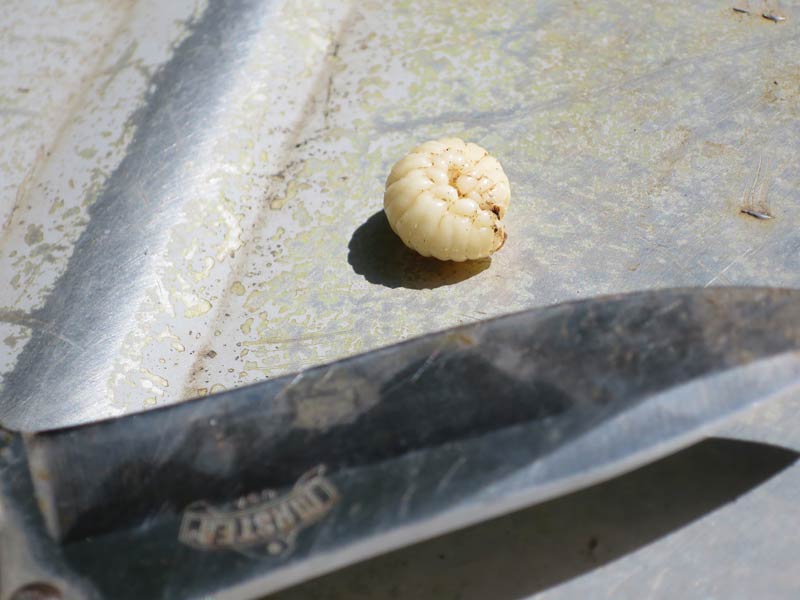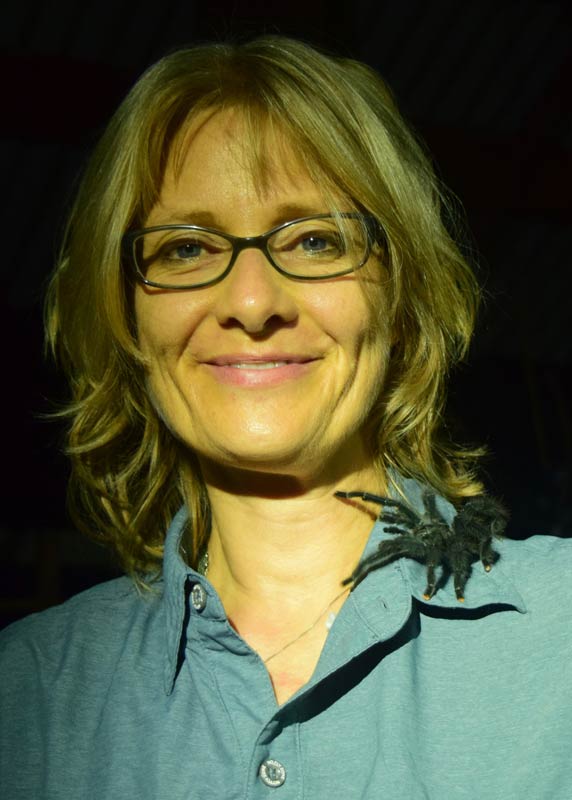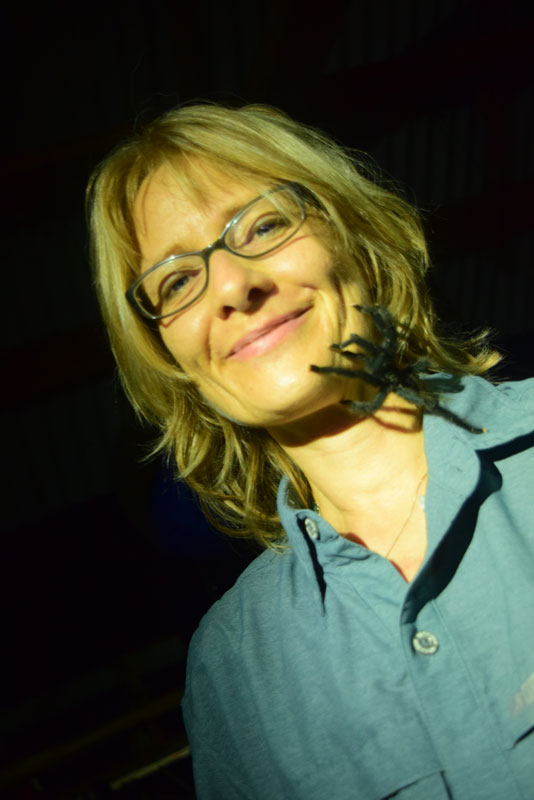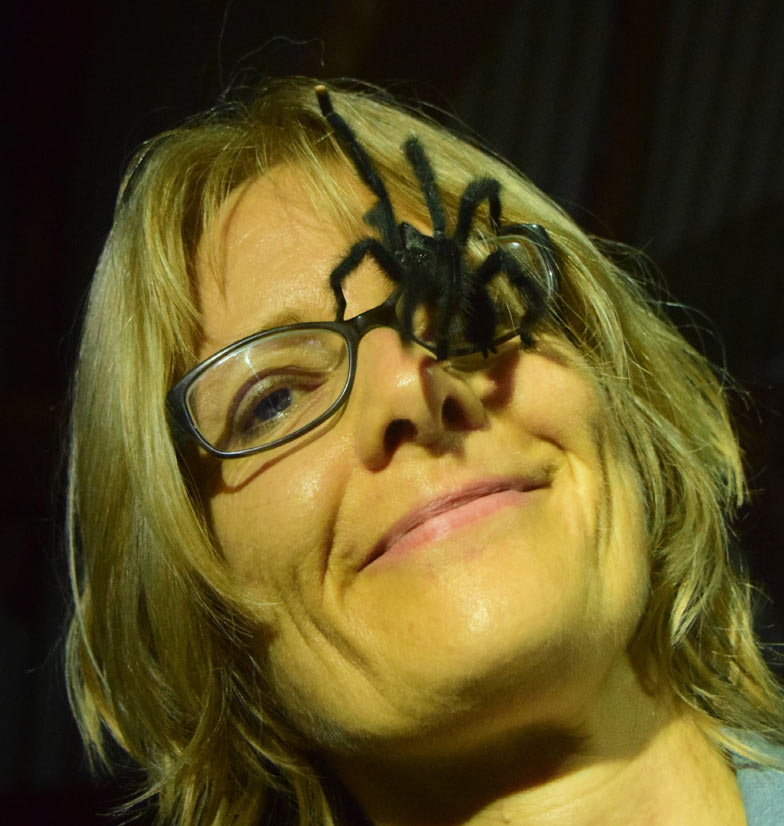I’m normally a late sleeper, but the contrast between the dark night and the bright morning light wakes me up at 6:00. Or maybe it’s the horde of howler monkeys, up in the trees not far away. They make a weird howling sound that sounds like the engines of a starting Boeing 747.
We meet for breakfast at 7:00, then have some free time. 8:00 first bow hunting lesson. We have two competition archers in the group and a cross bow hunter. My bow experience is very limited, mostly consisting of shooting 5 arrows at a time at the Renaissance Faire.

That’s me practicing before the trip (should’ve brought my boots to work that day!)
My 12-year old took archery in camp this summer and won archer of the year award. So, he took me to the archery range a few days before the trip and taught me the basics of recurve bow archery. Of course, I wasn’t very good. – “Mommy, if you have to depend on your hunting skills during isolation, you’re not going to eat!”
I guess I’ll find out whether I’m any better at shooting Amerindian bows than my son’s recurve! We each get issued a bow that vaguely matches our standing height. The string is plant cordage that Ian says works better than any other cordage that he has tried on these bows, like actual bow string, paracord, etc.
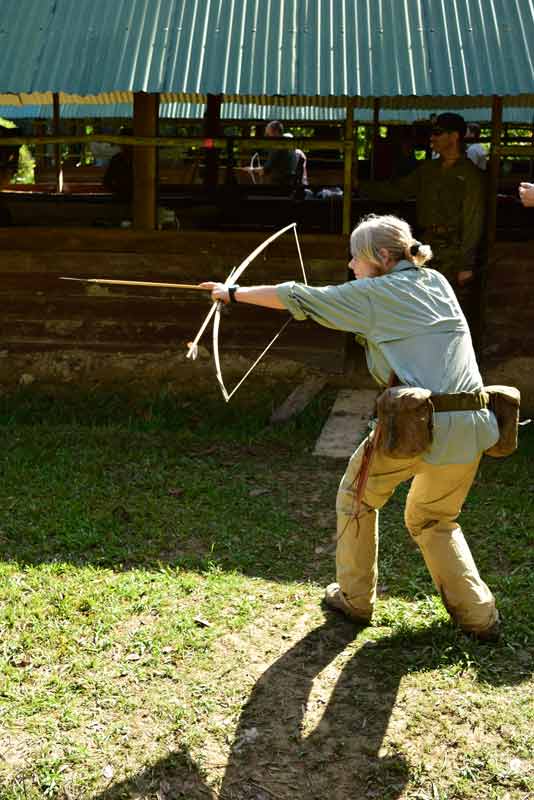 The bows are made from several kinds of wood, including the very rare leopard wood – a wood so rare that there is now a law that prohibits people from cutting down leopard wood trees. They may only take wood from fallen trees. Leopard wood, when polished, shimmers and shows a leopard skin pattern.
The bows are made from several kinds of wood, including the very rare leopard wood – a wood so rare that there is now a law that prohibits people from cutting down leopard wood trees. They may only take wood from fallen trees. Leopard wood, when polished, shimmers and shows a leopard skin pattern.
Since these bows are made of wood, they can break if too much force is applied. It is important to have the bow string be loose when the bow is not being used, and to only tighten the string before you use the bow (push your knee into the center of the bow to bend it and lift off the top loop of the string, then twist the string counter clockwise and reattach; you need to have at least one fist of space between bow center and string; if you have less, twist the string some more).
The bows also need to be watered to maintain their flexibility, so Ian sends us down to the river to dunk our bows in the water for a minute.
We each receive three arrows, made from the hollow stem of a local grass, with real feathers and a small nock at the end that fits on the bow string.The tip looks lethal: looks like a thick knitting needle, about 4 inches long.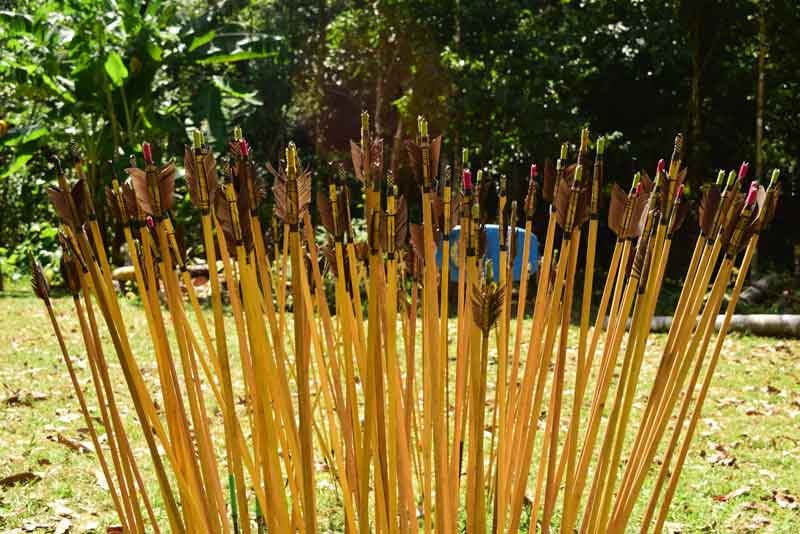 There are two targets set up: boogie boards with target rings sprayed on them and we split into two teams and start shooting, two at a time. Most of us miss most of the time. I was expecting to miss, so it doesn’t bother me too much, but some of the guys are getting frustrated because they typically do better with the bows they know.
There are two targets set up: boogie boards with target rings sprayed on them and we split into two teams and start shooting, two at a time. Most of us miss most of the time. I was expecting to miss, so it doesn’t bother me too much, but some of the guys are getting frustrated because they typically do better with the bows they know.
After bow hunting, Ian gives us a lecture on the environment we’re in: the tropical rain forest. Daylight hours, seasons, rain fall, vegetation, food chain. Most bio diversity on earth is in the sub-equatorial region (where our rainforest is located). He talks about dry and wet seasons: the rainforest here goes without rain for about 4 months, except for relief rain. Ian talks a bit about jungle plants and living with the jungle:
- On fruits: “you might as well be a fruitarian who only picks fruit that has fallen: because even if you do find a tree that has fruit, you cannot get it if it’s 150 feet up!”
- On living off of the rainforest: “everything in the forest is designed without humans in mind. We are totally irrelevant! We are not part of the food chain.”
- And on surviving in the jungle: “we have to be very adapted and use this” (points to his head); “the only thing we have that is better than anything else in here is this, the brain – we have to have a plan, understand the forest and how to use it, because we can’t change it”
The Basics of Fire-Making
Next, we learn to make fire. The key in the rain forest is to find wood that is dry enough to give you tinder. We all get issued a container filled with cotton balls and a Swedish (!) fire steel.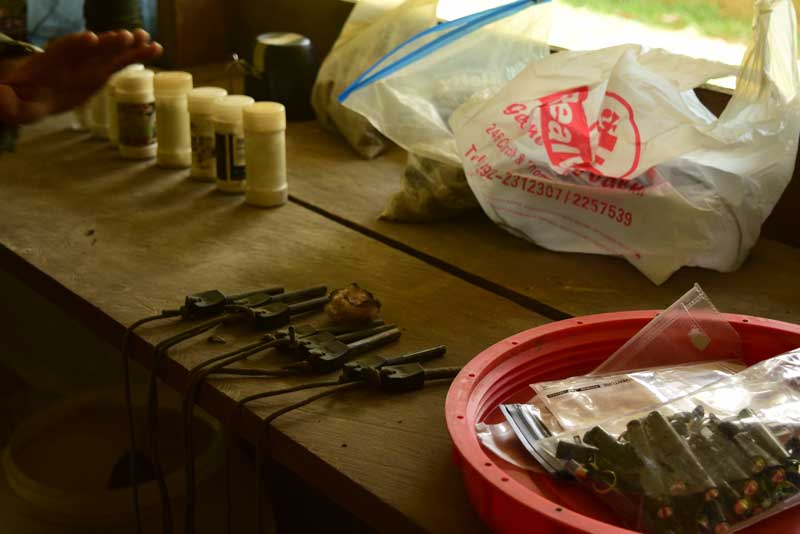
It’s part of our belt kit and we will take it into isolation. We get a fire steel because that always works, as opposed to relying on a lighter that may run out of fuel, or malfunction.
So, how do you find dry wood in the forest after a rainstorm? Best bet: find a STANDING dead tree (no dry leaves) and cut that down. Then cut sections and split one of them with your machete (set the machete in the center of the section and use another section of wood to hammer the machete into the wood so it splits the wood without you having to hold it (and without risking your fingers in the process).
Then use your machete to carve feather sticks: curve your fingers under and grab the tip of the machete with your left hand and then scrape it down the section of wood you just cut that is most likely dry inside, even after a rainstorm, because the tree was standing rather than sucking moisture in from the wet forest floor.
You cut one layer which curls up, slide the machete up and cut at a slightly different angle, another curl, and another and another, then push down so the curls get a “stem,” so you get a handle with lots of feathery curlicues on top. These are dry and the curls let in a lot of oxygen and help the fire catch faster and burn longer. This is what you put on, once your cotton ball ignites.
To keep your distance from the wet forest floor, lay a few sticks of wood down, dry or green doesn’t matter, just slightly apart so oxygen can get between them. Then pull apart one or two of the cotton balls, place them on the sticks and line up 4 or 5 feather sticks.
Then a bunch of little twigs. Then a bunch of bigger thicker twigs. Then some thin sticks. And then some thicker sticks. You gradually build the fire. Ian says it’s all about preparation. If you prepare well, you can start the fire. If you do not, and you rush things, fire starting is much more difficult.
Then comes the moment of truth: you ignite the cotton ball with the fire steel. – I have used a fire steel before and have always had issues with the fire steel hitting the tinder and messing up my “nest” of tinder materials.
Ian says that he’s never seen any of the survival books mention the correct use of the fire steel: rather than holding the fire steel in place and scraping the knife blade over it, forward, to generate sparks, hold the blade in place, over your tinder, and pull the fire steel BACKWARDS. That works like a charm!
I get my fire started on the first spark and the first cotton ball. I feed it feather sticks, then other little twigs, gradually adding more and thicker twigs, always making sure the fire has enough oxygen, adding new material in a “tepee” shape. I know I’m going to suck at a lot of the other things we’ll learn, but I know fire making is one of my skills!
After we all make fires, we have lunch, same as yesterday. Today I’m not really hungry and just have a little baggie of peanuts. And a cup of tea (now that we’re drinking river water, we have to add iodine: 3 drops per liter – leaves a very distinct taste, so I drink tea when I can, to disguise the taste of the iodine, and I use my leftover tea to refill my water bottle.).
Bait Fishing 101
Then we get our fishing gear: we all tie fishing hooks and weights, in different sizes, and fill another container for our belt kit with those hooks.
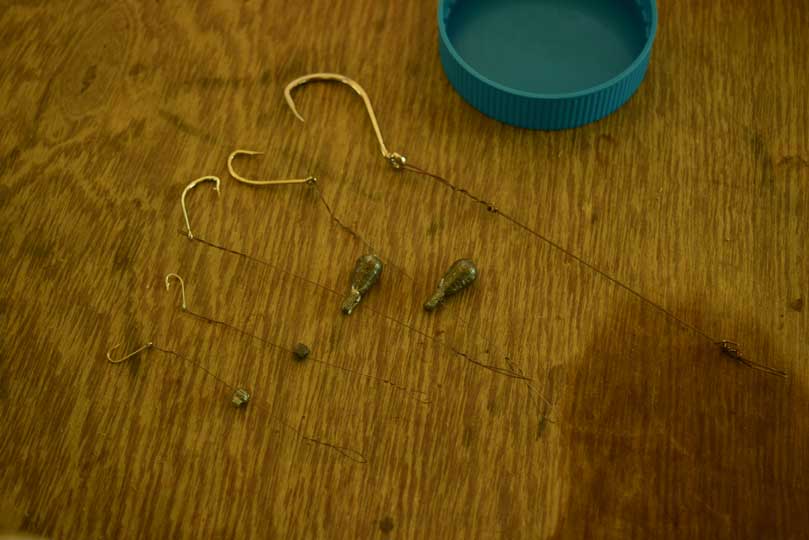
And we each get a yariyari stick (but basically any straight stick will do) as a fishing pole. We tie fishing line to the pole and the hook to the line and then are ready for bait fishing later this afternoon. Except, we need to get bait: kukrit grubs.
Lionel and Roy and Derrick have been out collecting kukrit nuts (from the mature kukrit palm tree) for us. They look like large pecans, but the shell is really really hard, way harder than brazil nuts. They teach us how to open them with our machetes.
They make a grabber for each of us (8 inch long stick of green wood, with two cuts at 90 degree angles, so there is a cross split in the top into which you wedge the rounder end of the nut. You hold the grabber tight with your left hand to clamp the nut in the grabber stick and push the stick against a round surface that allows the nut to rest against the surface but not the grabber. Then you hack at the nut with your machete, the exposed end of the nut, being careful to hit the same spot over and over until you cut through the hard shell of the nut into the interior.
You either get nutmeat (edible but hard to get out to eat) or sawdust (you’re too late, the grub has left the building) or, bingo, a grub! Ian says we each should get 6-10 grubs for our fishing trip this afternoon, but we all have to eat the first one. I have no issue with that. I have eaten lots of weird things in my life, especially on my trips to China. My issue is that my technique is terrible. I hit the nut, and every time it jumps out of the grabber. Or, if I keep it in, I can’t hit the same place more than once or twice.
I finally open two nuts and Lionel takes pity on me and opens a few more for me. I eat my first grub: soft, but when you bite the head, it crunches a little, tastes faintly coconutty, with a custardy interior – kind of like one of those jelly beans that’s hard on the outside and jelly-like on the inside. I can eat these all day long (and, if the fishing doesn’t go well, I may just have to do that in isolation!).
On to fishing: one team on the boat, the other team on land. I’m on the boat team. We cut our grubs in half to make them last longer and spear them on the hook of our yariyari sticks, then cast the line. I get a few nibbles, but no fish. Some of the others pull out one or two. All small. Little bait fish. We will take these and use them tonight during night fishing to attract larger fish.
After an hour or so, we return and do our bathing routine, then we each need to make a fire near our basha (hammock), and then dinner is at 6:30. Rice, farine and mystery meat with Del Monte mixed veggies. I had no breakfast today and just peanuts for lunch. I’m starving. And I’m tired. Ian is looking for the first group of volunteers for night fishing but I have to decline today. Too beat. B, O and D leave with Ian at around 7:30.
Eventually everyone leaves to go to bed, but I lie in the hammock in the mess hall and record my voice journal and have a nice cup of tea with milk (powder). Very relaxing. I enjoy sitting there for an hour or two until the guys come back.
You found WHAT on the river?
Turns out they brought an orphaned baby back! Well, baby spider that is: they saw a tarantula run across the water (they cross the river during the night because if they crossed during the day, they would end up as fish food) and Ian rescued her with the paddle and stashed her in his belt kit. He gently brings her out and lets her sit on his sleeve for a while, then gives her to O to hold and crawl around on. We take pictures. The tarantula goes on B next, then on me. Up my sleeve, onto my collar, my neck, then my face, and eventually my head and hair. Ian says they don’t bite unless scared or provoked and he says this one is calm. I trust him, so it’s really not a scary experience. And I get some badass pictures!
I hang with Ian and D for a while and we discuss truth in journalism, refugees in Europe and a bunch of other topics that are philosophical and controversial and rarely ever come up in any conversations I have. Really fascinating. I think I’m enjoying getting to know these people, and what makes them tick, almost as much as the whole survival challenge.
Click here to find the full list of posts: My Jungle Adventure

